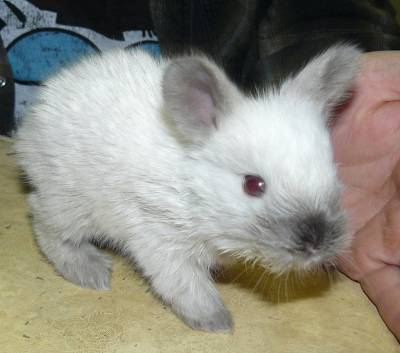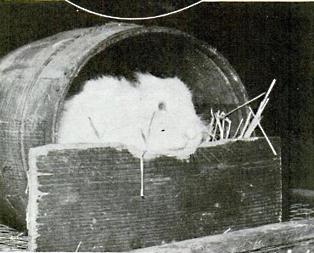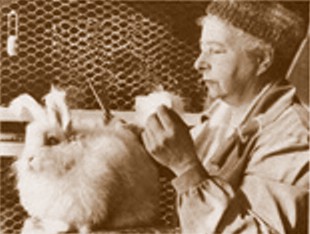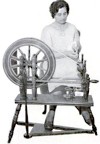Betty Chu offers advice from 30 years of Angora Rabbit breeding experience
Information from a webinar given by one of the most famous and admired breeders of English Angoras – Betty Chu.
To molt or not to molt. (Breeding “non-molting” Angora rabbits)
Betty Chu has the longest continuous and most distinguished career as an Angora rabbit breeder. This article was written by Betty Chu in 2012 for the use of the newsletter of the American Fuzzy Lop Rabbit Club. It is reprinted here with permission.
Linda Cassella on Breeding for Herd Improvement, and Angora Rabbit Care
 This article is compiled from a transcript of a webinar featuring Linda Cassella, which was sponsored by the Southern Angora Rabbit Club and moderated by Kelly Flading, on December 1, 2012, and was first published in the National Angora Rabbit Breeders Club’s Spring 2013 Angora News. Reprinted here with permission.
This article is compiled from a transcript of a webinar featuring Linda Cassella, which was sponsored by the Southern Angora Rabbit Club and moderated by Kelly Flading, on December 1, 2012, and was first published in the National Angora Rabbit Breeders Club’s Spring 2013 Angora News. Reprinted here with permission.
Revisiting “The Joys of Angora Rabbits,” by Dave Lewis
I first published this story that was written by long time Angora Rabbit breeder Dave Lewis, on the National Angora Rabbit Breeders Club website back in the mid 90’s. A lot of water has gone under the bridge since then, and the story touches my heart even more now. As it is a call for a rational perspective on what our woolly companions mean to us, I think it deserves a wider audience; therefore I am reprinting it here.
In the Judge’s Eye – the Show Ready Rabbit
By Travis Finkle, Angora Rabbit breeder and Rabbit & Cavy Judge #856.
Exhibitors quite often ask me what, as a judge, is my biggest pet peeve. That question is easy to answer: dirty or unruly animals. It upsets me every time this happens because it is something that can so easily be fixed. Ideally, if you are taking any rabbit to a show, it should be a show quality rabbit that is clean, well conditioned, well groomed, and well behaved.
5% produces 95% WINNERS
This short article by Marti Dill is a classic that used to be available on the ARBA.net website. It can no longer be found there, so I have posted it here, because I think it has such good points about selection for herd improvement.
DangerBunnyGirl’s Guide to Raising Orphaned Rabbits
(Reprinted with permission.)

…as some of you know I lost my sweet Angora doe a little under two weeks after she kindled, leaving me with six babies to take care of. I am sure there are many ways to do it well but this is what has worked for me, my babies are now over three weeks old, growing great and I didn’t lose any.
“Golden Fleece in your Back Yard,” a Popular Mechanics April 1940 article

Reading this Popular Mechanics article about Angora rabbits, published in 1940, I was surprised to find a reference to both French and English Angoras; I did not know that the two separate breeds were recognized then. The article is interesting from an historical point of view, as one reflects about the changes in rabbit management since then. It would be interesting to know who the author was. Read it and leave a comment about what you think!
Fuzzy Fad Distresses Lint-Covered Escorts

The page of photos below appeared in the LIFE magazine December 1948 issue. It makes much of Angora’s reputation for “shedding.” Of course, we Angora rabbit fanciers understand that when Angora garments shed, it is because the fiber was improperly harvested! I found this additional information about Lucille Griffith, who was apparently quite an Angora evangelist, in the Massachusetts, Pittsfield Berkshire Evening Eagle May 7, 1945 newspaper: “Miss Lucille Griffith, who raises angora rabbits at her home on Maple Street, gave a talk on her industry before the pupils of Center School, Dalton, last week. Miss Griffith showed a rabbit and her spinning wheel to the pupils.”
Raise Your Own Wool on a Back Yard Rabbit Ranch

This Popular Science 1937 article says, “In the small quarters of your own back yard, you can grow your mother’s fur coat, sister’s knitted suit, and brother’s sweater, with a pair of warm socks left over for dad. With two dozen Angora rabbits you can produce enough wool to supply the family with the finest knitted garments the market affords; and from the progeny of your first stock, you can secure fine pelts for neck pieces and coats which rival in beauty the most costly to be had anywhere. Tan your own skins, spin and dye your own yarn.”